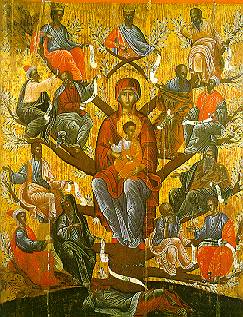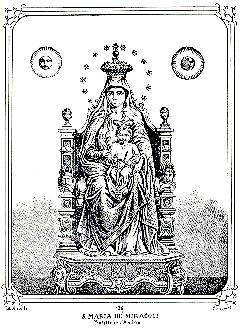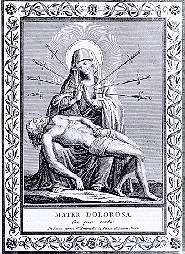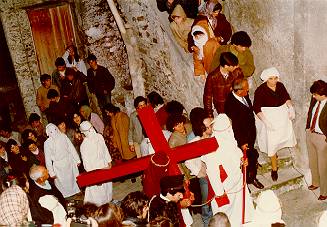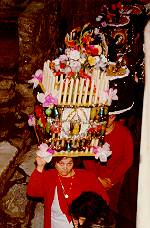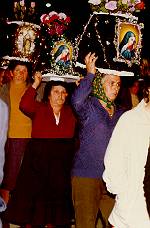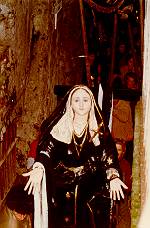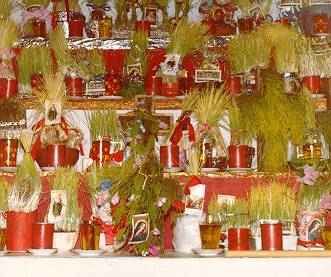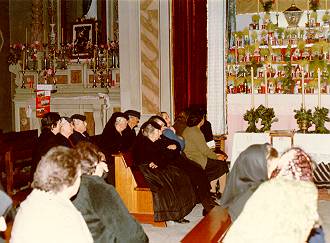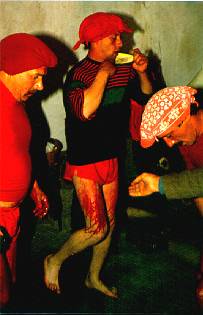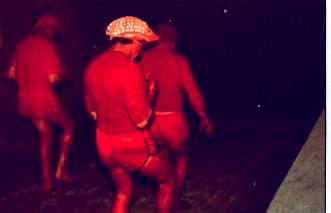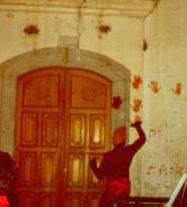| 5. The Mother of Sorrow In Catholic and Orthodox Christianity the role of women as pain-bearers finds support in the cult of a female figure, Mary, whose exceptional magnitude within the Christian hierarchy is one of the greatest peculiarities of Catholic and Orthodox Christianity with respect to Judaism and Islam. However, the prominence of Mary is not an original feature of Christianity: in the gospels she appears only as a marginal figure, as a poor woman from Galilee who was the mother of Jesus (and it should be added that the gospels of John and Mark do not mention at all the Annunciation of Mary, the birth of Jesus, and the related events narrated by Luke and Matthew). The cult of Mary developed later: only during the fifth century did the holy nature of Mary become a topic of theological debate. Given the strong influence of Hellenism on early Christianity, it is no wonder that the new Christian believers were in search of a female figure who could replace the Hellenistic goddesses. This led to forms of syncretism between Mary and many pre-Christian goddesses, such as the mother and redeemer Isis, whose worship was extremely widespread in the Roman Empire (C. Schneider 1967: 535, Baltrusaitis 1967, Magrini 1986: 116-122). The Council of Ephesus, held in 431 AD, stated that Mary was the Theotokos, the Mother of God, thus putting an end to the controversy that had troubled the early Christians. Since then the prominence of Mary in Christian Mediterranean Europe increased steadily, in particular after the beginning of the second millennium (Wolf 1969). This is obviously not the place to survey the history of Mariology: I will limit myself to the observation that the most important points of disagreement about Mary between the Catholic and Orthodox churches - which concern Mary's Immaculate Conception and her Assumption or Dormition - do not seem to have changed the perception of Mary in folk religion. As popular iconography shows, both Orthodox and Catholic people perceive Mary first of all as "the mother": her being the symbol of motherhood is the first reason for her prominence among Catholic and Orthodox believers. The role of Mary as mother is quite congruent with the basic role of women in both Catholic and Orthodox world, where they are considered essentially means of reproduction - differently from what happens in the Islamic world, where women are considered basically as sexual beings (see the article of Karin van Nieuwkerk in this number of M&A).
Since she represents the universal female experience of motherhood, whose relevance is stressed in the Christian Mediterranean world, Mary offers a model with whom Christian women can easily identify. As Gill Dubisch writes: "On the level of popular devotional practice, the prominence of Mary has been used to explain the frequently observed noted greater participation of lay women in everyday religious life throughout the Christian Mediterranean. Mary, it is argued, provides a model for women in their daily lives, the model of the self-sacrificing and virtuous mother. This model is congruent with expected social roles for women, whereas "the virtues exemplified by Christ do not provide such a satisfactory role model for Mediterranean men" (Dubisch 1995: 233; see also Saunders 1981: 440) (2). In Nancy Frey Breuner's words: "Mary represents the ideal mother, the ultimate paragon, and she derives her power from the qualities of self-denial and nurturance. Women may respond to that image because they identify with these attributes, which are consonant with their experience in society" (Breuner 1992: 79). It seems to me, however, that Mary is something more than simply a model of motherhood: one cannot forget that she is the "Mother of Sorrow", the mother who lost her son, and who experienced the greatest possible grief. It is the experience of grief that makes Mary such a human figure, that makes her close to all Christian Mediterranean women who have to endure pain in their everyday life. The prominence of the Mother of Sorrow is testified for instance by the impressive rituals for Easter, currently the most popular Christian rituals in Southern Europe (see Boissevain 1992). The traditional representation of the Mother of Sorrow with her breast pierced by seven swords provides a most vivid interpretation of Mary's suffering. This suffering is often conceived of as important as Christ's own passion: Christ died, was resurrected, and joined his father in heaven, but Mary remained on earth to mourn her dead son (Dubisch 1995: 214-5).
During the procession the women play a silent, though very expressive, role: they carry on their heads the cinti, that is, devotional objects that may either be full of grain or support a set of candles. Light and food are thus the symbols that are associated with femininity during the ritual and represent the woman as feeder (whose archetype is the nursing mother) and redeemer. The Easter procession:
Christ with the Jews
Moreover, at Easter, in Northern Calabria as well as in many other regions of Southern Italy (e.g. Giallombardo 1977: 18), the women also prepare the so-called lavurieddi or crocette. They store some plants of grain in a dark room, so that the grain, because of the lack of light, grows yellow or light green rather than dark green, and thus becomes a symbol of the white body of the dead Christ. These plants, placed on a wooden cross (crocette) or, alternatively, in little pots (lavurieddi), are then put on the altars together with an image of Christ or of the Mother of Sorrow: they represent the grain that cannot grow, thus the same theme of death through the metaphor of food The dramatic climax of the Holy Week is reached on the night before Good Friday, when two separate rituals take place, one performed by women, the other one by men, in one of these villages. The old women gather together and sing in the main church, located in the heart of the village, thus performing the most important part of their "work of pain". What they sing is in fact a planctus, that is, the lament of the Mother of Sorrow for her dead son. The melodic design is indeed characteristic of the lament, as well as the text.
In her planctus, the mother recalls the beauties of her son, his cheeks, his holy feet, his holy hands, his sweet mouth, his bright eyes, his golden hair, and compares every trait of the living Jesus with the miserable look of the dead Christ. The mother tells Jesus that he was both husband and father to her, even though she actually bore him. She tells him that she cannot stop mourning, she wants to keep him on her breast and wash him with her tears; she begs him to let her stay with him in his grave, and - when he answers that this is not possible - she tells him that she will wait until he comes out of the tomb, and that if he does not come out she will start to cry and to tell the reason of her mourning to everybody, and that she will mourn him as long as she will live (Magrini 1986: 413-417). There is clearly a strict relationship between this planctus Mariae and the ritual of the lament mentioned above. This relationship becomes apparent, for instance, in the way in which the mourning Mary dialogues with her dead son and, above all, in her desperate attempt to deny the reality of the irreparable loss: in fact, the lament has generally the form of an ideal dialogue between the mourner and the dead, through which the mourner refuses to admit the actuality of death. At the same time, this planctus displays the characteristic therapeutic aspects of the lament: in fact, finding ways to transform pain through words, gestures, and sounds is the first step towards the overcoming of pain and towards the reintegration of the bereaved into reality. At any rate, it is important to emphasize here that the main agent of this therapeutic practice is not Mary, of course, but rather those women who, by performing the planctus, can find the words, the sounds, and the gestures to carry on their own "work of pain" and to lament symbolically their own losses. However, the ritual of the lament of the Mother of Sorrow has also an important part in the representation of Mary as a powerful model of the suffering woman - a model full of humanity. It is no wonder that Christian women may easily identify with her as their first "fellow woman" in the experience of grief (see Toschi 1976: 685). Of course, there may be further contextual circumstances that reinforce the message of this ritual. If we accept the idea that Easter, in addition to its religious meaning, takes on a wider significance as emblematic representation of an experience of loss and detachment, then the identification with the Mater Dolorosa becomes even more meaningful for the women of these villages. On the one hand, they live in a region in which uxorilocal residence is practiced (Magrini 1986: 23-24), which means that mothers must experience detachment from their sons when they get married (this loss counterbalances the women's privilege of living in close contact with their native family). On the other side, we cannot overlook the fact that so many people from this Italian region were forced to emigrate elsewhere in search of jobs and economic security. This might be a further reason why these women are so sensitive to the theme of loss and detachment. The prominence of the Mother of Sorrow within the Easter rituals, in this context, is enhanced further by the behavior of the men of the same village during the night of Good Friday. While the women lament the death of Christ in the main church, some men perform the ritual of the battenti outside the church. Dressed in red, with their face partly covered, the battenti wound their own legs, then run barefoot across the village and offer their blood to the Mother of Sorrow on the steps or on the walls of some churches.
It must be emphasized that this ritual is not related to the death of Christ, but rather to the fulfillment of a personal vow to the Mother of Sorrow. Viewed in psychoanalytic terms, this behavior may be connected to a deep unresolved feeling of dependence on the mother, symbolically represented by the Mater Dolorosa (see Magrini 1986: 92-109). However, for the purpose of this paper it is more important to emphasize that the behaviors of men and women during this ritual are completely different: while the men offer a physical sacrifice, like in many other Christian rituals, the women offer their ability to elaborate psychological suffering. This may perhaps be taken as a hint to understand the different roles associated with femininity and masculinity within ritual-religious events. There is no doubt that Easter rituals provide the occasion for the most direct identification of women with Mary as Mother of Sorrow. The role of the suffering Mother, however, also appears in other ritual actions, such as pilgrimages. As it is well-know, pilgrimages are a very complex and polymorph phenomenon that may be studied from a variety of perspectives (e.g. Bohlman 1996, Boissevain 1992, Dubisch 1995). I only would like to point out here that most pilgrimage sites in Southern Europe are sanctuaries dedicated to the Madonna (for instance, in Southern Italy, nearly 40% of sanctuaries). This figure itself points to the exceptional status of the Madonna in popular devotion. Pilgrimages are not only a female phenomenon; men participate too. But, according to the literature and my own experience, the "work of pain" carried on during pilgrimages seems once again performed mostly by women, by means of behaviors that are widespread both in Catholic and in Orthodox Christianity and have been observed in various regions of Southern Europe. These behaviors involve actions that are generally performed before arriving at the sanctuary or at the holy icon or statue within it. They may include the following: crawling towards the sanctuary on the knees, walking barefoot, dragging the tongue on the ground, breast-beating, touching and kissing holy objects, loosening the hair, bringing offerings, wearing a white dress (that will be left at the sanctuary as an offering), shouting, crying, swooning, invoking the Madonna, insistently begging for a grace (e.g., Rossi 1986: 76, Dubisch 1995, Brandes 1980). Devotional behavior may thus include self-humiliation and public display of pain. By performing these actions, women affirm their particular role of taking on themselves their pain, as well as that of their children, their husbands, and other members of their family, and of acting according to a resolution obtained through divine grace. Thus the manifestation of suffering becomes again a means to reaffirm the women's role as actors of the "work of pain". Moreover, "the identification with the Panayia [Mary] as a suffering mother lends a particular moral force to their own performance of suffering as enacted at the pilgrimage site" (Dubisch 1995: 217). It is worth stressing that, besides using materials offered by traditional religious behavior in order to perform a public representation of their pain, women also create images that are central to religion : "Their ritual and prayer focus not on Christ, but on the Panayia. Instead of the martyred son, they produce and reproduce images of the suffering mother" (Dubisch 1995: 219). Pilgrimage is often accompanied by singing, performed while travelling toward or walking around the pilgrimage site. Singing is another important part of the devotional behavior of the worshippers and illustrates their relationship with the Madonna. The songs celebrate the power of the Madonna - as the mother of all people and as the mistress of the whole world - praise her beauty, depict her while helping the worshippers in the different moments of their journey to the sanctuary, and generally conclude by requesting a grace (Magrini 1986: 394-409).
These songs portray the Madonna as an omnipotent holy figure who can satisfy any need of her worshippers. At the same time, through her being the "Mother of all people," she appears endowed with a human dimension that allows her to understand and share the pain of her devotees, protect them and fulfil their needs. In this way, the same privileged understanding of suffering that creates a bond among the women on earth also creates a bond between these women and our Lady in Heaven: the notion of shared pain provides the reward of female bonding. At the same time, just as the women act as mediators between their families and the sacred world, the Madonna is often conceived as a mediator between the humans and God or Christ. |
||||||||||||||||||||
